TOYOTA RAV4 2006 Service Repair Manual
Manufacturer: TOYOTA, Model Year: 2006, Model line: RAV4, Model: TOYOTA RAV4 2006Pages: 2000, PDF Size: 45.84 MB
Page 441 of 2000
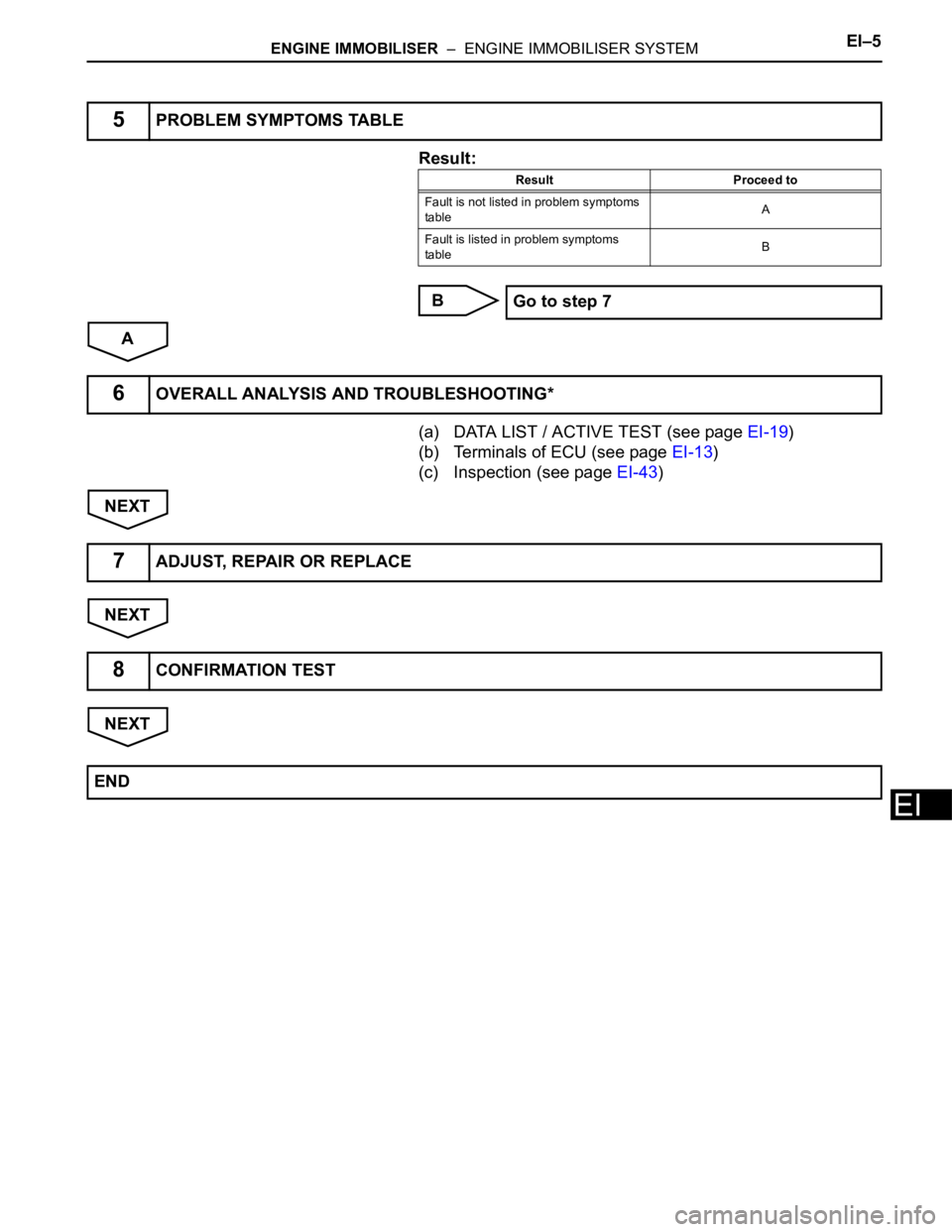
ENGINE IMMOBILISER – ENGINE IMMOBILISER SYSTEMEI–5
EI
Result:
B
A
(a) DATA LIST / ACTIVE TEST (see page EI-19)
(b) Terminals of ECU (see page EI-13)
(c) Inspection (see page EI-43)
NEXT
NEXT
NEXT
5PROBLEM SYMPTOMS TABLE
Result Proceed to
Fault is not listed in problem symptoms
tableA
Fault is listed in problem symptoms
tableB
Go to step 7
6OVERALL ANALYSIS AND TROUBLESHOOTING*
7ADJUST, REPAIR OR REPLACE
8CONFIRMATION TEST
END
Page 442 of 2000

CC–4CRUISE CONTROL – CRUISE CONTROL SYSTEM
CC
SYSTEM DIAGRAM
Communication table
Sender Receiver Signal Line
ECM Skid control ECU with actuator• VSC operation signal
• Coast brake operation signalCAN
ECM Combination meterCRUISE main indicator light
signalCAN
E129446E01
Page 443 of 2000

CRUISE CONTROL – CRUISE CONTROL SYSTEMCC–5
CC
SYSTEM DESCRIPTION
1. CRUISE CONTROL SYSTEM
This system is controlled by the ECM, and is activated by
the throttle position sensor and motor. The ECM controls
the following functions: ON-OFF, SET / COAST,
RESUME / ACCEL, CANCEL, vehicle speed operation,
motor output control, and overdrive control.
• The ECM compares the driving vehicle speed from
the combination meter with the stored vehicle speed
set through the cruise control switch. The ECM
controls the throttle valve motor of the throttle body to
open the valve when the driving speed is less than the
stored speed.
• The ECM receives signals such as ON-OFF, SET /
COAST, RESUME / ACCEL, and CANCEL from the
cruise control switch.
• The ECM illuminates the combination meter CRUISE
main indicator light when it receives the cruise control
switch ON signal.
• The ECM cancels the cruise control system when the
brake pedal is depressed and the ECM receives the
stop light switch signal.
• The ECM cancels the cruise control system when the
shift lever is moved from D or 3 to a position other
than D or 3, and the ECM receives the PNP switch
signal.
2. LIMIT CONTROL
(a) Low speed limit
The lowest possible limit of the speed setting range
is set at approximately 40 km/h (25 mph). The
cruise control system cannot be set when the
driving vehicle speed is below the low speed limit.
Cruise control operation will be automatically
canceled when the vehicle speed decreases below
the low speed limit 40 km/h (25 mph) while the
cruise control is in operation.
(b) High speed limit
The highest possible limit of the speed setting range
is set at approximately 200 km/h (125 mph). The
cruise control system cannot be set when the
driving vehicle speed is over the high speed limit.
Also, +/RES cannot be used to increase speed
beyond the high speed limit.
Page 444 of 2000

CC–6CRUISE CONTROL – CRUISE CONTROL SYSTEM
CC
3. OPERATION OF CRUISE CONTROL
The cruise control switch operates 7 functions: SET,
COAST, TAP-DOWN, RESUME, ACCELERATION
(ACCEL), TAP-UP, and CANCEL. The SET, TAP-DOWN
and COAST functions, and the RESUME, TAP-UP and
ACCEL functions are operated with the same switch.
The cruise control switch is an automatic return type
switch which turns on only when pressed in each arrow
direction and turns off when released.
(a) SET CONTROL
Vehicle speed is stored and constant speed control
is maintained when pushing the switch to -/SET
while driving with the cruise control switch ON (the
CRUISE main indicator light is illuminated), and the
vehicle speed is within the set speed range
(between the low and high speed limits).
(b) COAST CONTROL
The ECM changes the cruise control demanding
throttle opening angle to 0
and decelerates the
vehicle when -/SET on the cruise control switch is
pressed and held while the cruise control system is
operating. When the cruise control switch is
released from -/SET, the vehicle speed is stored and
constant speed control is maintained.
HINT:
• The throttle valve is not fully closed due to idle
speed control, etc.
•w/ VSC:
The brake is also used to decelerate the vehicle.
(c) TAP-DOWN CONTROL
When tapping down the cruise control switch to -/
SET (for approximately 0.5 seconds) while the
cruise control system is in operation, the stored
vehicle speed decreases each time by
approximately 1.6 km/h (1.0 mph). When the cruise
control switch is released from -/SET and the
difference between the driving and stored vehicle
speed is less than 5 km/h (3 mph), the vehicle
speed is stored and constant speed control is
maintained.
(d) ACCEL CONTROL
The throttle valve motor of the throttle position
sensor and motor is instructed by the ECM to open
the throttle valve when +/RES on the cruise control
switch is pressed and held while the cruise control
system is operating. When the cruise control switch
is released from +/RES, the vehicle speed is stored
and constant speed is maintained.
Page 445 of 2000

CRUISE CONTROL – CRUISE CONTROL SYSTEMCC–7
CC
(e) TAP-UP CONTROL
When tapping up the cruise control switch to +/RES
(for approximately 0.5 seconds) while the cruise
control system is in operation, the stored vehicle
speed increases each time by approximately 1.6
km/h (1.0 mph). However, when the difference
between the driving and the stored vehicle speed is
more than 5 km/h (approximately 3.1 mph), the
stored vehicle speed will not be changed.
(f) RESUME CONTROL
If the cruise control operation was canceled with the
stop light switch or the CANCEL switch, and if
driving speed is within the set speed range, setting
the cruise control switch to +/RES restores the
vehicle speed memorized at the time of
cancellation, and constant speed is maintained.
(g) MANUAL CANCEL CONTROL
Performing any of the following cancels the cruise
control system (the stored vehicle speed in the ECM
is maintained).
• Depressing the brake pedal
• Moving the shift lever to any position except D or
3
• Pulling the cruise control switch to CANCEL
• Pushing the cruise control switch OFF (the
stored vehicle speed in the ECM is not
maintained)
4. AUTO CANCEL (FAIL-SAFE)
This system has an automatic cancellation function (fail-
safe) (see page CC-17).
Page 446 of 2000
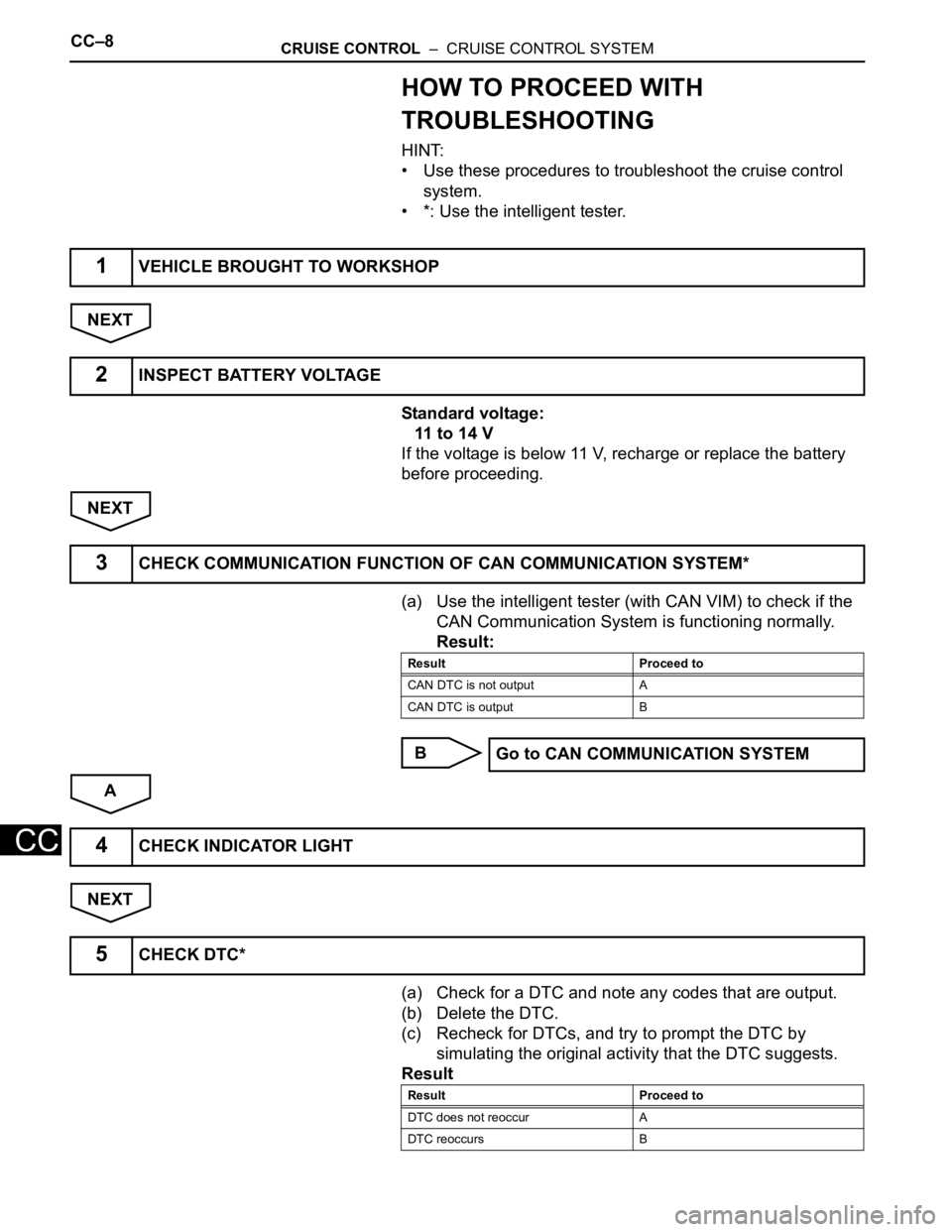
CC–8CRUISE CONTROL – CRUISE CONTROL SYSTEM
CC
HOW TO PROCEED WITH
TROUBLESHOOTING
HINT:
• Use these procedures to troubleshoot the cruise control
system.
• *: Use the intelligent tester.
NEXT
Standard voltage:
11 to 14 V
If the voltage is below 11 V, recharge or replace the battery
before proceeding.
NEXT
(a) Use the intelligent tester (with CAN VIM) to check if the
CAN Communication System is functioning normally.
Result:
B
A
NEXT
(a) Check for a DTC and note any codes that are output.
(b) Delete the DTC.
(c) Recheck for DTCs, and try to prompt the DTC by
simulating the original activity that the DTC suggests.
Result
1VEHICLE BROUGHT TO WORKSHOP
2INSPECT BATTERY VOLTAGE
3CHECK COMMUNICATION FUNCTION OF CAN COMMUNICATION SYSTEM*
Result Proceed to
CAN DTC is not output A
CAN DTC is output B
Go to CAN COMMUNICATION SYSTEM
4CHECK INDICATOR LIGHT
5CHECK DTC*
Result Proceed to
DTC does not reoccur A
DTC reoccurs B
Page 447 of 2000
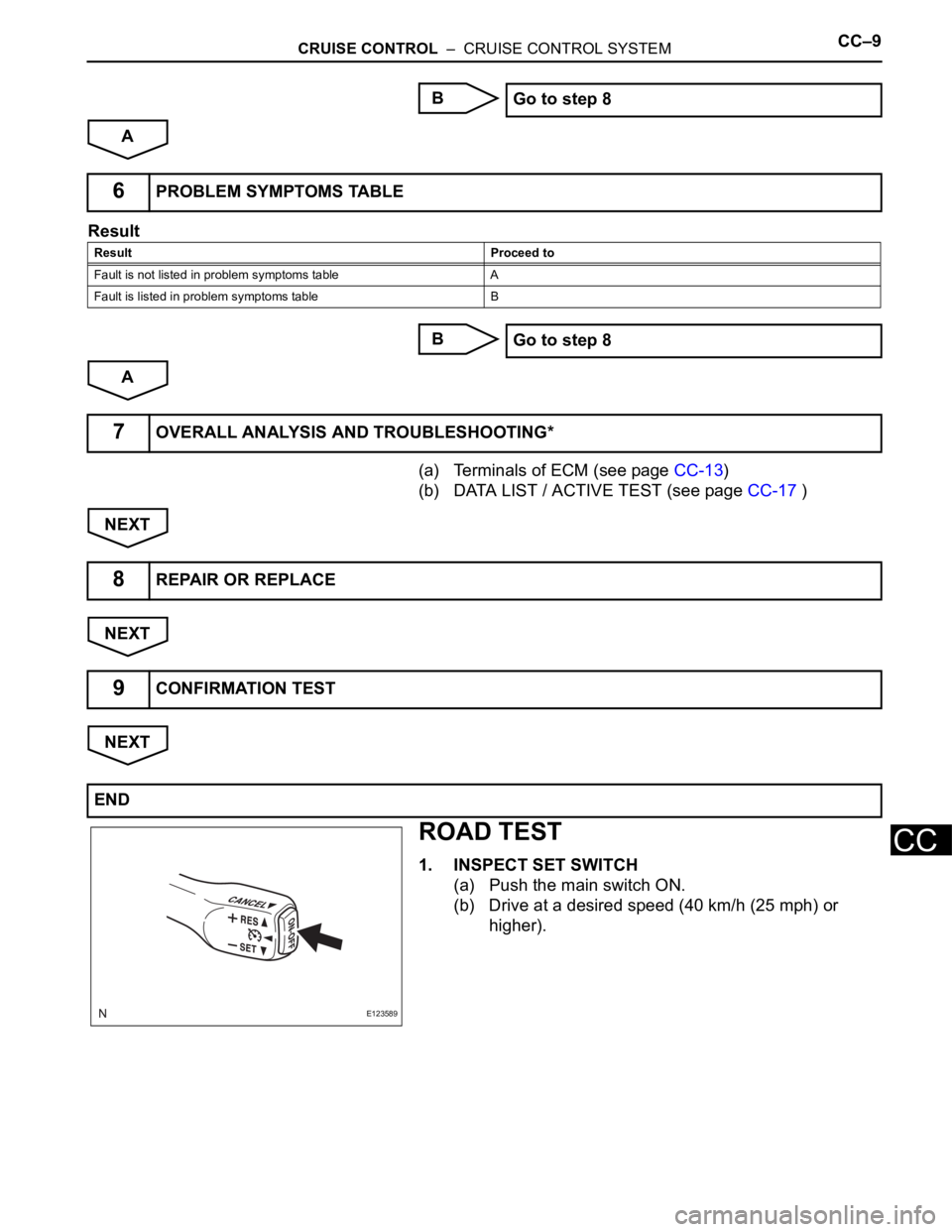
CRUISE CONTROL – CRUISE CONTROL SYSTEMCC–9
CC
B
A
Result
B
A
(a) Terminals of ECM (see page CC-13)
(b) DATA LIST / ACTIVE TEST (see page CC-17 )
NEXT
NEXT
NEXT
ROAD TEST
1. INSPECT SET SWITCH
(a) Push the main switch ON.
(b) Drive at a desired speed (40 km/h (25 mph) or
higher).Go to step 8
6PROBLEM SYMPTOMS TABLE
Result Proceed to
Fault is not listed in problem symptoms table A
Fault is listed in problem symptoms table B
Go to step 8
7OVERALL ANALYSIS AND TROUBLESHOOTING*
8REPAIR OR REPLACE
9CONFIRMATION TEST
END
E123589
Page 448 of 2000
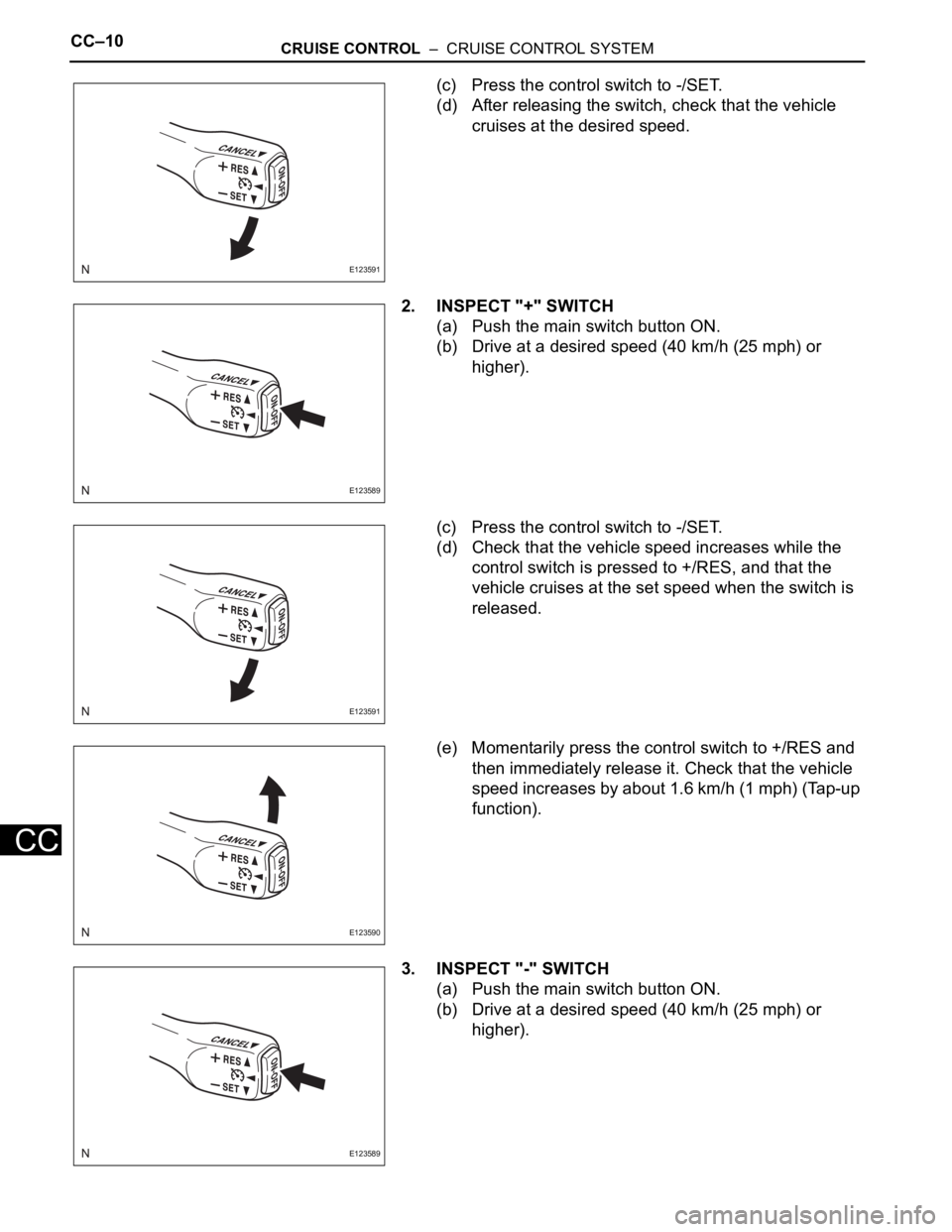
CC–10CRUISE CONTROL – CRUISE CONTROL SYSTEM
CC
(c) Press the control switch to -/SET.
(d) After releasing the switch, check that the vehicle
cruises at the desired speed.
2. INSPECT "+" SWITCH
(a) Push the main switch button ON.
(b) Drive at a desired speed (40 km/h (25 mph) or
higher).
(c) Press the control switch to -/SET.
(d) Check that the vehicle speed increases while the
control switch is pressed to +/RES, and that the
vehicle cruises at the set speed when the switch is
released.
(e) Momentarily press the control switch to +/RES and
then immediately release it. Check that the vehicle
speed increases by about 1.6 km/h (1 mph) (Tap-up
function).
3. INSPECT "-" SWITCH
(a) Push the main switch button ON.
(b) Drive at a desired speed (40 km/h (25 mph) or
higher).
E123591
E123589
E123591
E123590
E123589
Page 449 of 2000
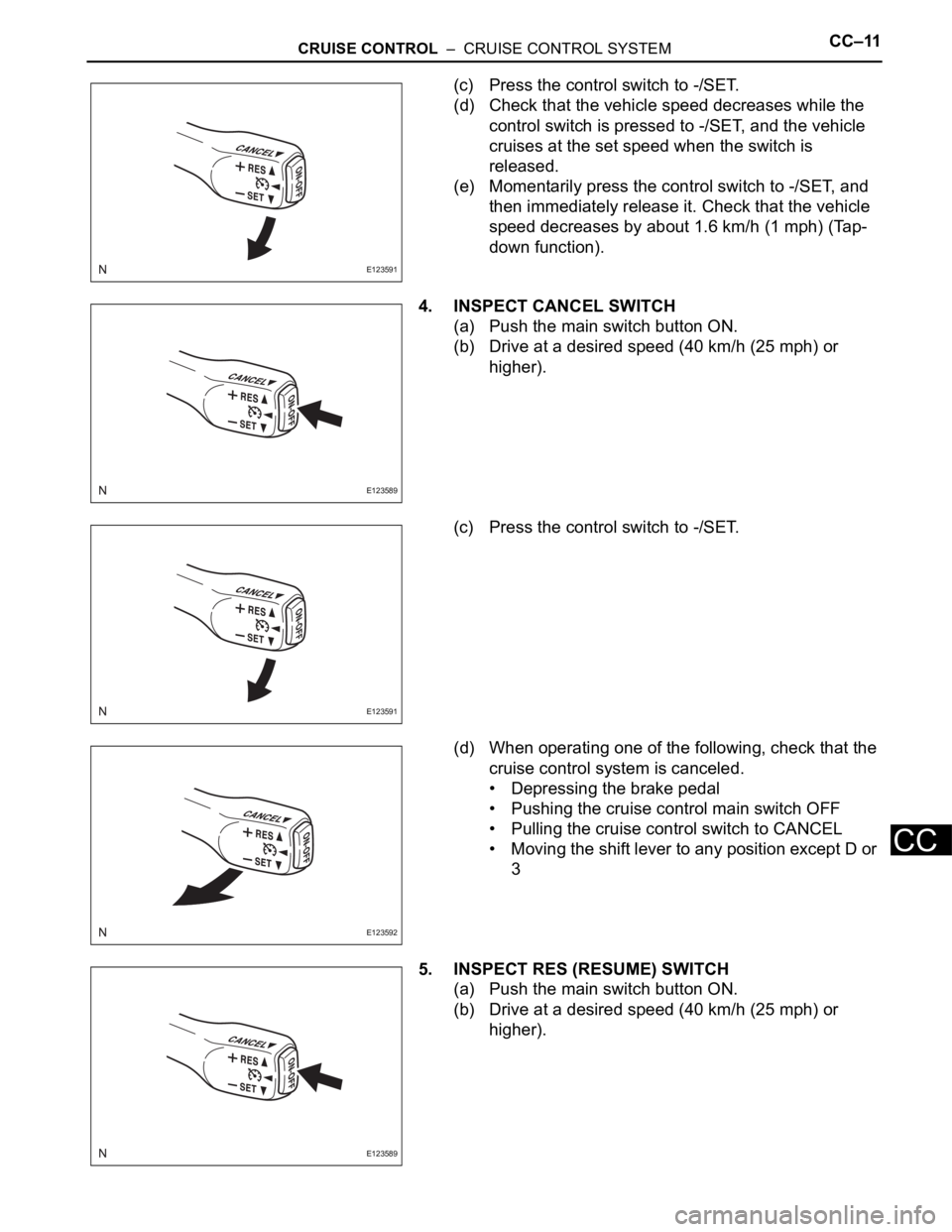
CRUISE CONTROL – CRUISE CONTROL SYSTEMCC–11
CC
(c) Press the control switch to -/SET.
(d) Check that the vehicle speed decreases while the
control switch is pressed to -/SET, and the vehicle
cruises at the set speed when the switch is
released.
(e) Momentarily press the control switch to -/SET, and
then immediately release it. Check that the vehicle
speed decreases by about 1.6 km/h (1 mph) (Tap-
down function).
4. INSPECT CANCEL SWITCH
(a) Push the main switch button ON.
(b) Drive at a desired speed (40 km/h (25 mph) or
higher).
(c) Press the control switch to -/SET.
(d) When operating one of the following, check that the
cruise control system is canceled.
• Depressing the brake pedal
• Pushing the cruise control main switch OFF
• Pulling the cruise control switch to CANCEL
• Moving the shift lever to any position except D or
3
5. INSPECT RES (RESUME) SWITCH
(a) Push the main switch button ON.
(b) Drive at a desired speed (40 km/h (25 mph) or
higher).
E123591
E123589
E123591
E123592
E123589
Page 450 of 2000
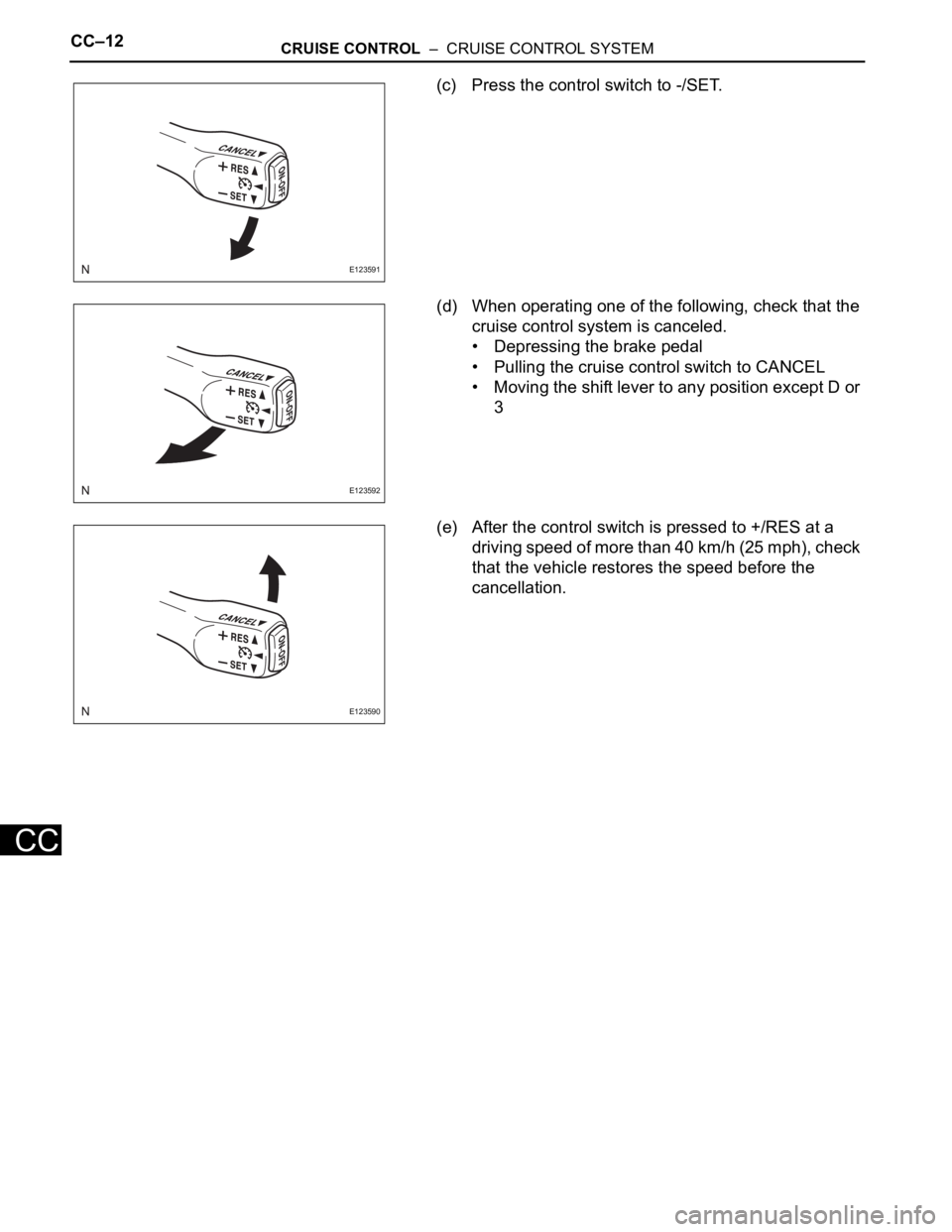
CC–12CRUISE CONTROL – CRUISE CONTROL SYSTEM
CC
(c) Press the control switch to -/SET.
(d) When operating one of the following, check that the
cruise control system is canceled.
• Depressing the brake pedal
• Pulling the cruise control switch to CANCEL
• Moving the shift lever to any position except D or
3
(e) After the control switch is pressed to +/RES at a
driving speed of more than 40 km/h (25 mph), check
that the vehicle restores the speed before the
cancellation.
E123591
E123592
E123590